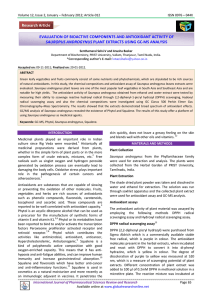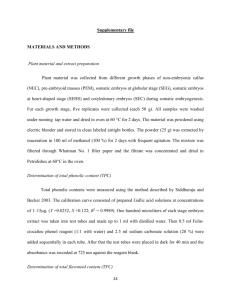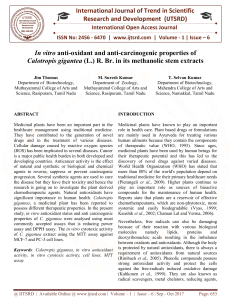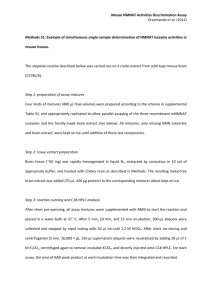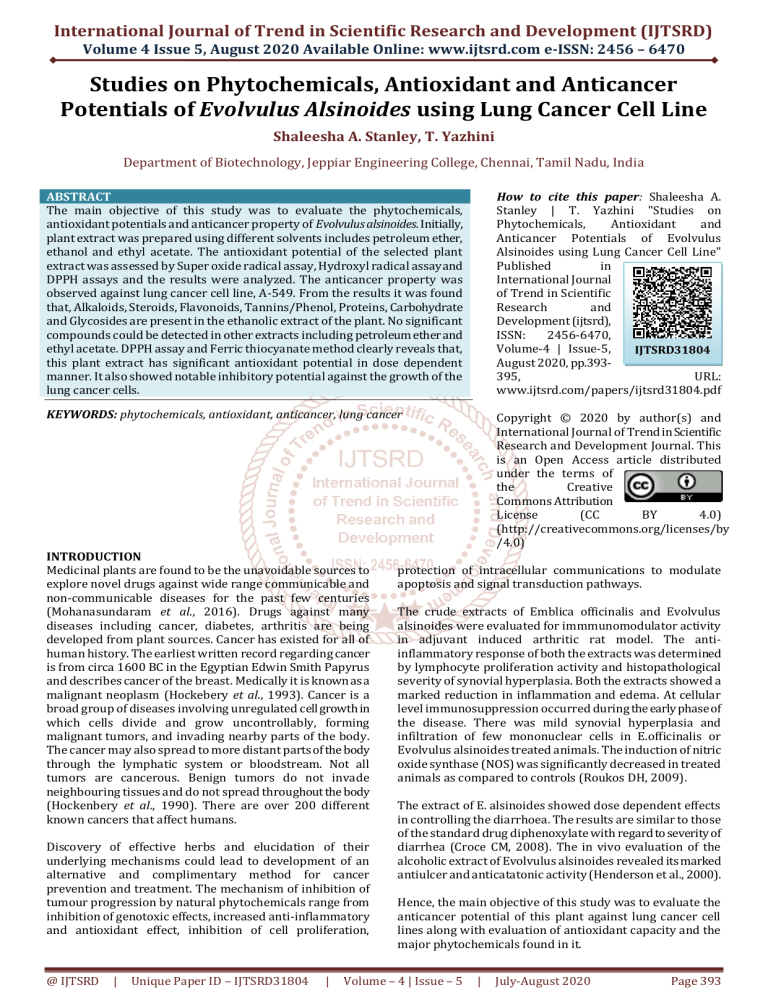
International Journal of Trend in Scientific Research and Development (IJTSRD)
Volume 4 Issue 5, August 2020 Available Online: www.ijtsrd.com e-ISSN: 2456 – 6470
Studies on Phytochemicals, Antioxidant and Anticancer
Potentials of Evolvulus Alsinoides using Lung Cancer Cell Line
Shaleesha A. Stanley, T. Yazhini
Department of Biotechnology, Jeppiar Engineering College, Chennai, Tamil Nadu, India
ABSTRACT
The main objective of this study was to evaluate the phytochemicals,
antioxidant potentials and anticancer property of Evolvulus alsinoides. Initially,
plant extract was prepared using different solvents includes petroleum ether,
ethanol and ethyl acetate. The antioxidant potential of the selected plant
extract was assessed by Super oxide radical assay, Hydroxyl radical assay and
DPPH assays and the results were analyzed. The anticancer property was
observed against lung cancer cell line, A-549. From the results it was found
that, Alkaloids, Steroids, Flavonoids, Tannins/Phenol, Proteins, Carbohydrate
and Glycosides are present in the ethanolic extract of the plant. No significant
compounds could be detected in other extracts including petroleum ether and
ethyl acetate. DPPH assay and Ferric thiocyanate method clearly reveals that,
this plant extract has significant antioxidant potential in dose dependent
manner. It also showed notable inhibitory potential against the growth of the
lung cancer cells.
How to cite this paper: Shaleesha A.
Stanley | T. Yazhini "Studies on
Phytochemicals,
Antioxidant
and
Anticancer Potentials of Evolvulus
Alsinoides using Lung Cancer Cell Line"
Published
in
International Journal
of Trend in Scientific
Research
and
Development (ijtsrd),
ISSN:
2456-6470,
Volume-4 | Issue-5,
IJTSRD31804
August 2020, pp.393395,
URL:
www.ijtsrd.com/papers/ijtsrd31804.pdf
KEYWORDS: phytochemicals, antioxidant, anticancer, lung cancer
Copyright © 2020 by author(s) and
International Journal of Trend in Scientific
Research and Development Journal. This
is an Open Access article distributed
under the terms of
the
Creative
Commons Attribution
License
(CC
BY
4.0)
(http://creativecommons.org/licenses/by
/4.0)
INTRODUCTION
Medicinal plants are found to be the unavoidable sources to
explore novel drugs against wide range communicable and
non-communicable diseases for the past few centuries
(Mohanasundaram et al., 2016). Drugs against many
diseases including cancer, diabetes, arthritis are being
developed from plant sources. Cancer has existed for all of
human history. The earliest written record regarding cancer
is from circa 1600 BC in the Egyptian Edwin Smith Papyrus
and describes cancer of the breast. Medically it is known as a
malignant neoplasm (Hockebery et al., 1993). Cancer is a
broad group of diseases involving unregulated cell growth in
which cells divide and grow uncontrollably, forming
malignant tumors, and invading nearby parts of the body.
The cancer may also spread to more distant parts of the body
through the lymphatic system or bloodstream. Not all
tumors are cancerous. Benign tumors do not invade
neighbouring tissues and do not spread throughout the body
(Hockenbery et al., 1990). There are over 200 different
known cancers that affect humans.
Discovery of effective herbs and elucidation of their
underlying mechanisms could lead to development of an
alternative and complimentary method for cancer
prevention and treatment. The mechanism of inhibition of
tumour progression by natural phytochemicals range from
inhibition of genotoxic effects, increased anti-inflammatory
and antioxidant effect, inhibition of cell proliferation,
@ IJTSRD
|
Unique Paper ID – IJTSRD31804
|
protection of intracellular communications to modulate
apoptosis and signal transduction pathways.
The crude extracts of Emblica officinalis and Evolvulus
alsinoides were evaluated for immmunomodulator activity
in adjuvant induced arthritic rat model. The antiinflammatory response of both the extracts was determined
by lymphocyte proliferation activity and histopathological
severity of synovial hyperplasia. Both the extracts showed a
marked reduction in inflammation and edema. At cellular
level immunosuppression occurred during the early phase of
the disease. There was mild synovial hyperplasia and
infiltration of few mononuclear cells in E.officinalis or
Evolvulus alsinoides treated animals. The induction of nitric
oxide synthase (NOS) was significantly decreased in treated
animals as compared to controls (Roukos DH, 2009).
The extract of E. alsinoides showed dose dependent effects
in controlling the diarrhoea. The results are similar to those
of the standard drug diphenoxylate with regard to severity of
diarrhea (Croce CM, 2008). The in vivo evaluation of the
alcoholic extract of Evolvulus alsinoides revealed its marked
antiulcer and anticatatonic activity (Henderson et al., 2000).
Hence, the main objective of this study was to evaluate the
anticancer potential of this plant against lung cancer cell
lines along with evaluation of antioxidant capacity and the
major phytochemicals found in it.
Volume – 4 | Issue – 5
|
July-August 2020
Page 393
International Journal of Trend in Scientific Research and Development (IJTSRD) @ www.ijtsrd.com eISSN: 2456-6470
Materials and Methods
Plant Material
The fresh sample of the plant was collected and
authenticated. The fresh leaves were washed in running tab
water and shade dried for one week in the laboratory
conditions. The dried sample was ground into fine powder
using mechanical grinder. Different solvents, petroleum
ether, ethanol and ethyl acetate were used for the extraction
using soxhlet apparatus.
Figure 1 DPPH assay of E.alsinoides and standard
Ascorbic acid
Phytochemical analysis
The major phytochemical present in the plant sample in all
the three solvents were analyzed using the standard proven
procedure (Harbone, 1998, VA Doss et al., 2016).
Antioxidant and anticancer properties
The suspected antioxidant potential was assessed by DPPH
assay, Super oxide radical assay and Hydroxyl radical assay
using the standard proven methods (Mohanasundaram et al.,
2019). The invitro anticancer property was studied by MTT
assay using lung cancer cell line, A-549 (Mohanasundaram et
al., 2019).
Results and Discussion
Table 1 Phytochemical analysis of Evolvulus
alsinoides
Petroleum
Ethyl
Compound
Ethanol
ether
acetate
Alkaloids
+
+
-Steroids
+
+
+
Flavanoids
-+
+
Tannins/Phenol
-+
-Proteins
-+
-Carbohydrate
+
+
-Glycosides
+
+
+
Terpenoids
--+
“+” – Present
““ - Absent
The qualitative phytochemical analysis of the selected plant
using different solvents were analyzed. It showed (Table 1)
very clearly that the ethanolic extract was found to be best
and containing most of the phytocompounds. Hence, the
ethanolic extract was chosen for further analysis.
Antioxidant Assays
DPPH Assay
The results of DPPH assay (Fig. 1) notably exemplify that the
ethanolic extract of our plant showed significant scavenging
activity against DPPH radicals and the results obtained are
almost similar to that of earlier study (Mohanasundaram et
al., 2019). At 1000mg, ethanolic extract showed 66.42% of
inhibition DPPH radical generation whereas standard
showed 71.65% of inhibition. Hence, this extract could be
potential therapeutic choice against diseases like cancer
where extensive cell damages are witnessed.
@ IJTSRD
|
Unique Paper ID – IJTSRD31804
|
Superoxide Radical Scavenging Assay
The Superoxide Radical Scavenging assay is an another
supporting evidence (Fig.2) for the antioxidant potential of
the ethanolic extract of our plant. Similar to that of DPPH
assay, the antioxidant potential of the extract has been
witnessed as dose dependent. The results are similar and
comparable to earlier study (Mohanasundaram et al., 2019).
At 1000mg, ethanolic extract showed 77.06% of inhibition
DPPH radical generation whereas standard showed 76.11%
of inhibition.
Figure 2 Superoxide radical scavenging assay of
E.alsinoides and standard Ascorbic acid
Hydroxyl radical scavenging assay
The ethanolic extract of E.alsinoides showed (Fig. 3) 47.88%
inhibition of hydroxyl radical generation and the standard
showed 54.12% of inhibition. The gradual increase in the
antioxidant potential has been witnessed when the
concentration increases from 200 to 1000mg in all the
antioxidant assays.
Figure 3 Hydroxyl Radical Scavenging Assay of
E.alsinoides
Volume – 4 | Issue – 5
|
July-August 2020
Page 394
International Journal of Trend in Scientific Research and Development (IJTSRD) @ www.ijtsrd.com eISSN: 2456-6470
Cytotoxicity Assay (MTT Assay)
The MTT assay showed (Figure 4) the possible cytotoxic
potential of the ethanolic extract of the E.alsinoides against
the growth of lung cancer cell line, A-459. The gradual
increase in the cytotoxicity was observed when the
concentration of the plant extract increases from 25mg to
50, 75 and 100mg.
Figure 4 MTT Assay of E.alsinoides
thoroughly to isolate the exact compounds being responsible
for the suspected bioactivities and hence further studies are
warranted.
Reference
[1] Mohanasundaram.S, Victor Arokia Doss, Prasad
Maddisetty (2016). Hepato-renal protective effects of
hydroethanolic extract of Senna alata on enzymatic and
non-enzymatic antioxidant systems in streptozotocin
induced diabetic rats. Integr Med Res 5: 276–283
[2] Hockebery. D., Z. Oltvai, X.-M. Yin, C. Milliman, and S. J.
Korsmeyer, 1993. Iki-2 functions in an antioxident
pathway apoptosis. Cell. 75:241-251.
[3] Hockenbery. D., G. Nunez, C. Mllliman, R. D. Schreiber,
and S. J. Kors- meyer, 1990. Bcl-2 is an inner
mitochondrial membrane protein that blocks
programmed cell death. Nature (Lond.). 348:334-336.
[4] Roukos DH (April 2009). "Genome-wide association
studies: how predictable is a person's cancer risk?".
Expert Rev Anticancer Ther 9 (4): 389–92.
doi:10.1586/era.09.12. PMID 19374592
From the results, we have observed around 68.74% of
inhibition after 72Hr at the concentration of 100mg/dL. In
the same duration, 55.31% and 47.81% of inhibition of
cancer growth has also been witnessed at the concentration
of 100mg/dL after 48 and 24Hrs respectively. The results
are comparable with earlier study (Mohanasundaram et al.,
2019), and hence, the extract can be potential choice of
therapy against cancer.
It has been proven in so many studies that, antioxidants can
be used as a therapeutic option to eradicate major illness
including cancer. When, any natural found to contain both
antioxidant and cytotoxic potentials are undoubtedly a best
option to use against wide range of diseases.
Conclusion
The ethanolic extract of E.alsinoides was found to contains
the major phytochemicals like alkaloids, phenols, flavanoids,
saponins, etc. The antioxidant assays of the ethanolic extract
showed its huge potential against wide range of free radical
generation and in addition to this, it has also been
characterized with huge cytotoxicity against the growth of
lung cancer cell line. Hence, this extract should be studied
@ IJTSRD
|
Unique Paper ID – IJTSRD31804
|
[5] Croce CM (January 2008). "Oncogenes and cancer". N.
Engl. J. Med. 358 (5): 502–11. PMID 18234754.
[6] Henderson BE, Bernstein L, Ross RK (2000). "Chapter
13: Hormones and the Etiology of Cancer". In Bast RC,
Kufe DW, Pollock RE, et al.. Holland-Frei Cancer
Medicine (5th ed.). Hamilton, Ontario: B.C. Decker.
ISBN 1-55009-113-1. Retrieved 27 January 2011.
[7] Victor Arokia Doss, Mohanasundaram.S, Prasad
Maddisetty (2016). Analysis of hydroethanolic extract
of Senna alata (L.) to screen bioactive compounds with
inhibitory activity on lipid peroxidation, in vitro
antibacterial and antidiabetic efficacy. Int J Pharma Sci.,
6(1): 1360-1366.
[8] Harbone, J. B., (1998) ‘Phytochemical Methods’. A guide
to modern techniques of plant analysis 3rd edn.
Chapman and Hall, New York, 1‐150.
[9] Mohanasundaram S, Victor Arokia Doss, Prasad
Maddisetty, Magesh R, Sivakumar K and Subathra M
(2019). Pharmacological analysis of hydroethanolic
extract of Senna alata (L.) for in vitro free radical
scavenging and cytotoxic activities against HepG2
cancer cell line. Pak. J. Pharm. Sci., Vol.32, No.3, May
2019, pp.931-934.
Volume – 4 | Issue – 5
|
July-August 2020
Page 395


